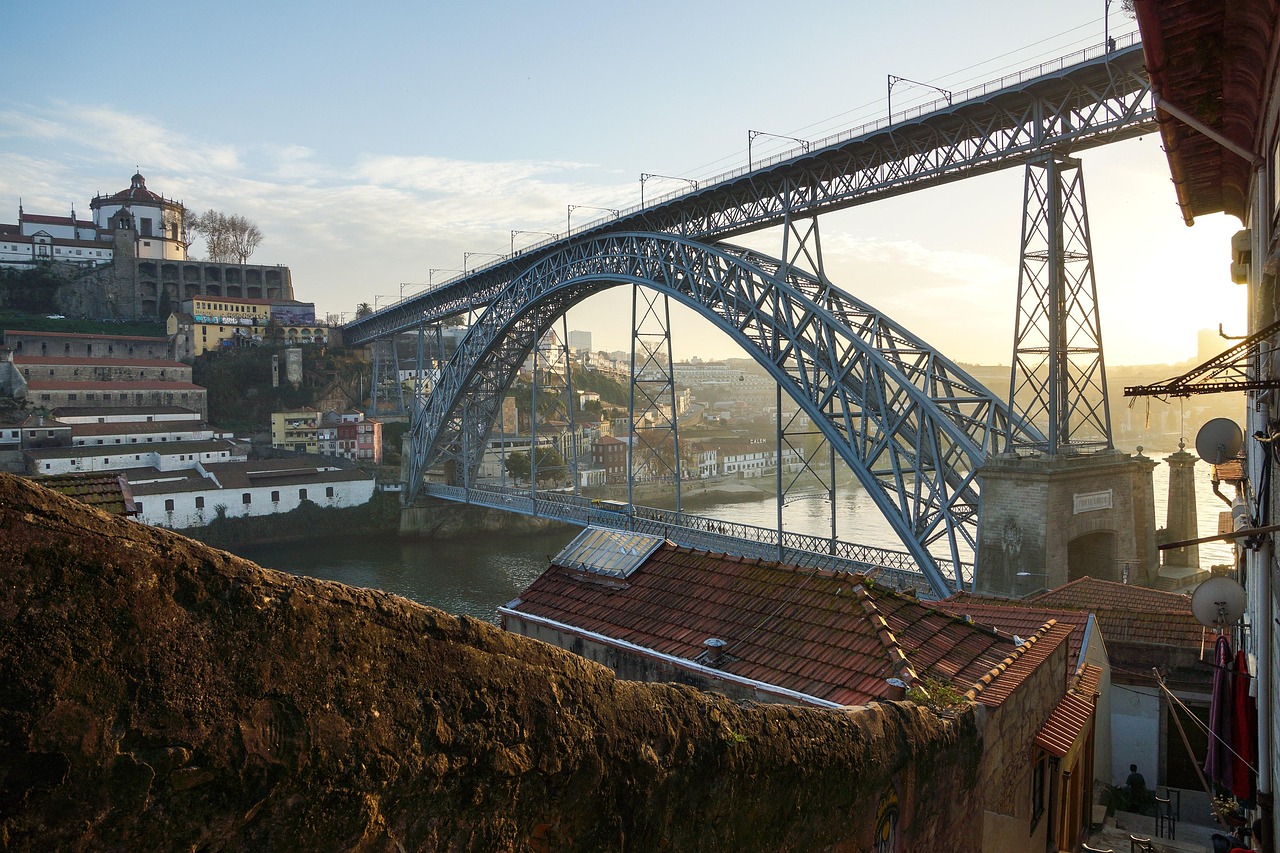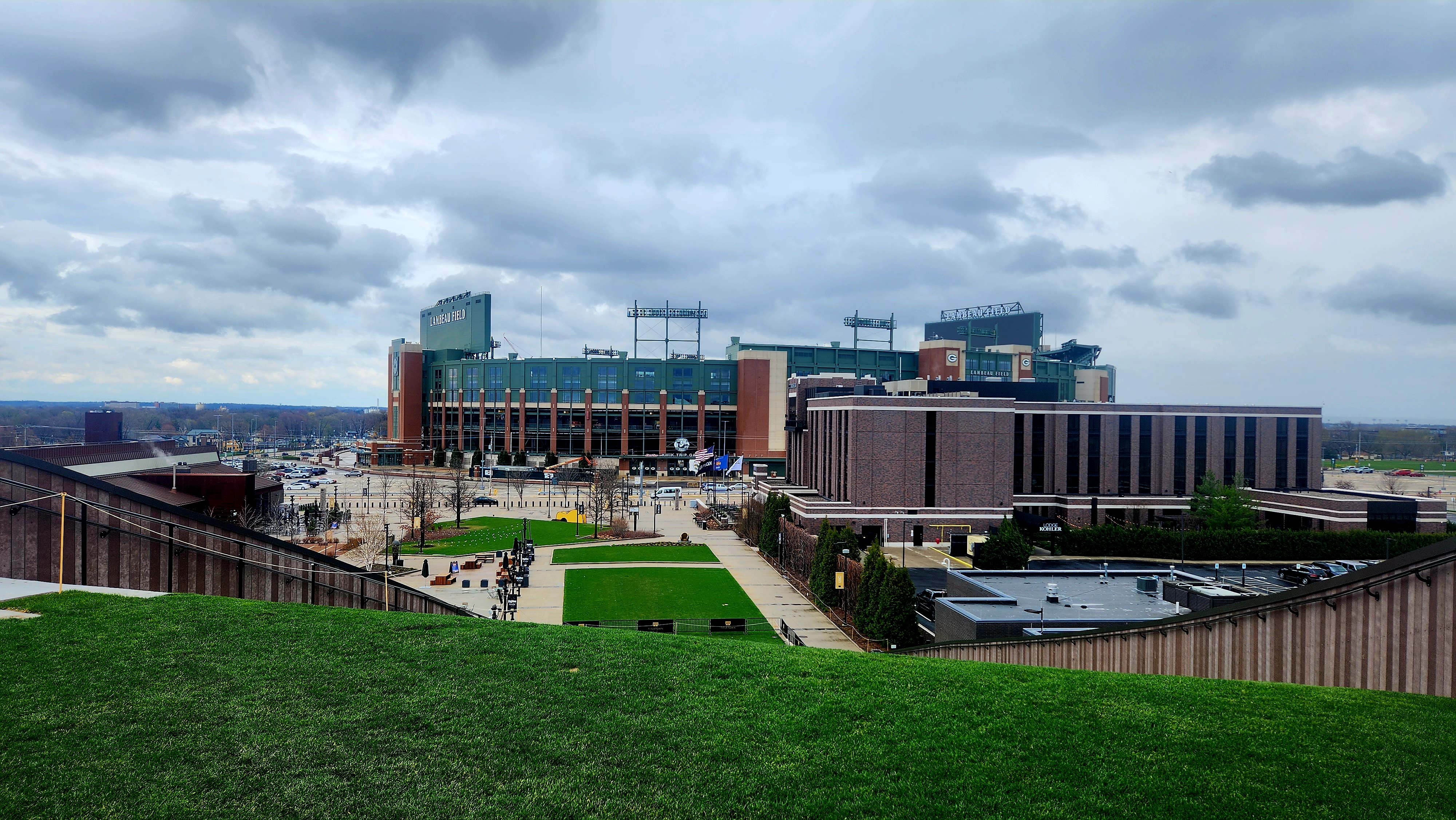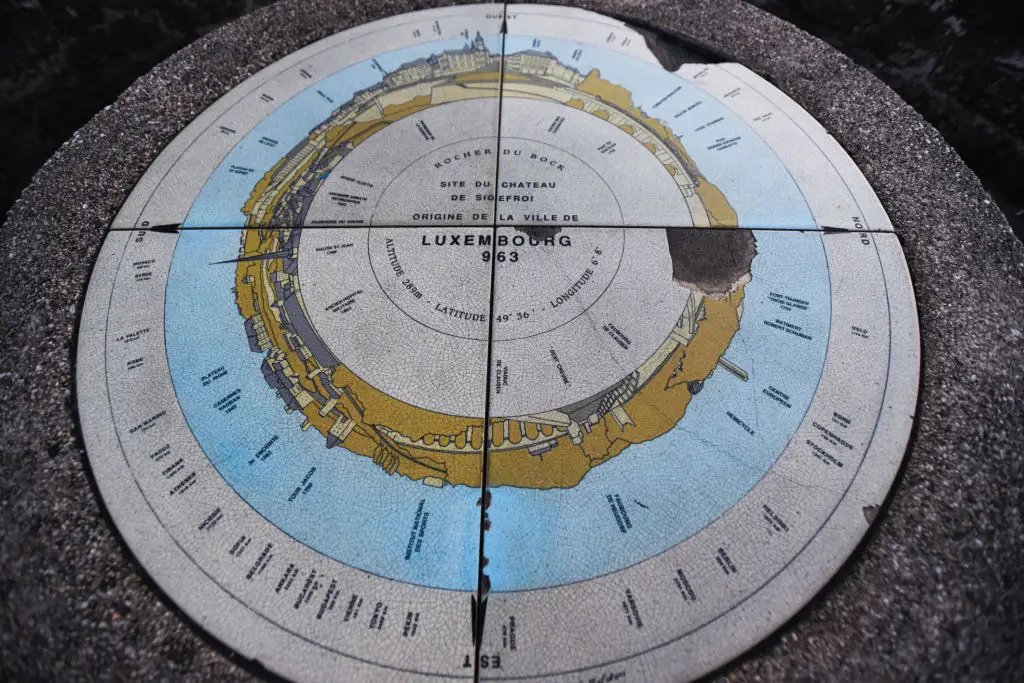23 Creepy Colossal Monuments That Put Humanity In Perspective
Some monuments inspire awe—others unsettle. Scattered across the world, colossal statues and structures loom over landscapes, their sheer size and presence enough to make you feel tiny, powerless, and watched. Whether they were built to honor gods, rulers, or forgotten ideologies, many of these monuments have taken on an uncanny, almost otherworldly aura, standing as ghostly relics of human ambition and mystery. We've expanded our list to 23 eerie, enormous monuments that put humanity in perspective—statues that stare blankly over cities, abandoned colossi swallowed by time, and giant figures that seem to defy logic itself. Some are carved into mountains, others rise from empty plains, their cracked stone faces and lifeless eyes carrying secrets of lost civilizations and long-dead leaders. Whether they're forgotten, cursed, or simply too massive to ignore, these unsettling titans remind us of the fleeting nature of power and the eerie permanence of stone, metal, and forgotten faiths. Are you brave enough to stand beneath them?
1. The Laykyun Setkyar Buddha – Myanmar’s Towering Wonder

Hidden deep in the heart of Myanmar, the Laykyun Setkyar Buddha is a mesmerizing monument that rises an astonishing 116 meters (381 feet) into the sky, making it one of the tallest statues in the world. Located in the town of Monywa, this colossal golden figure of Buddha stands atop a 13.5-meter (44-foot) pedestal, giving it an even more commanding presence over the lush, green landscape. Unlike many massive statues that stand alone, Laykyun Setkyar is part of a larger spiritual complex, surrounded by hundreds of smaller Buddha figures, each carefully placed to create a tranquil, meditative atmosphere. At its feet, an immense reclining Buddha stretches out for nearly 91 meters (300 feet), symbolizing the Buddha’s final moments before attaining nirvana. This massive reclining form adds to the surreal beauty of the site, turning it into one of the most visually striking religious locations in the world. The construction of Laykyun Setkyar took over a decade, finally reaching completion in 2008, making it one of the more recent colossal monuments of devotion.
2. The Ushiku Daibutsu – Japan’s Sky-High Buddha
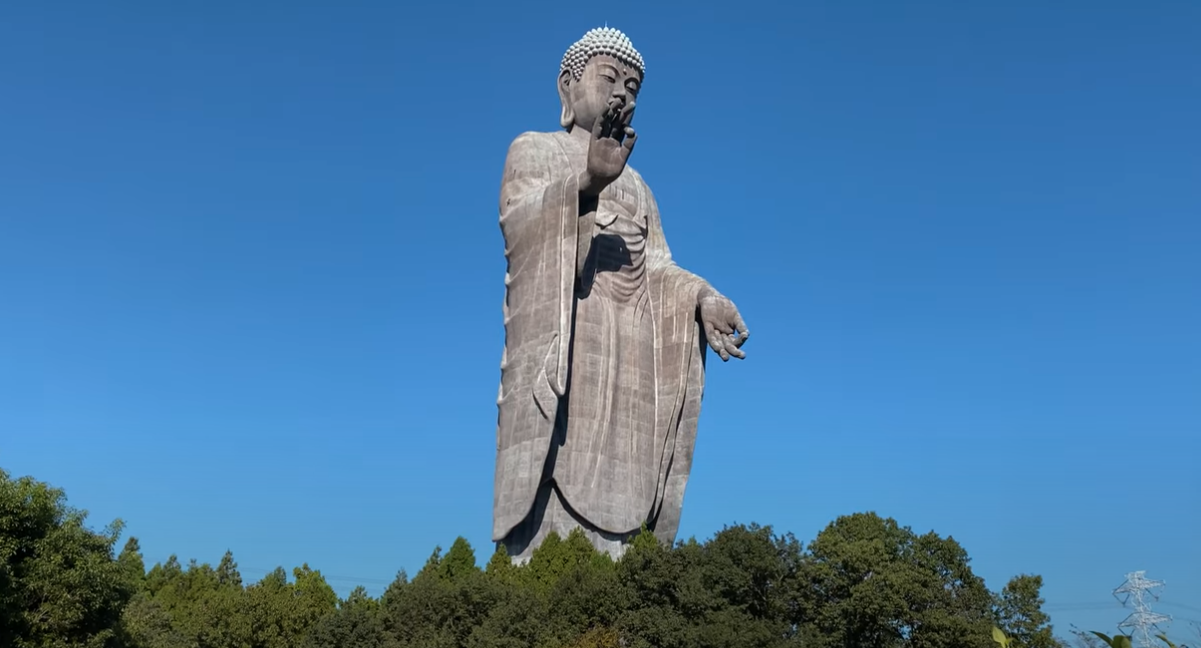
Towering over the countryside of Ibaraki Prefecture, Japan, the Ushiku Daibutsu is a record-breaking statue of Amitabha Buddha, standing at 120 meters (394 feet) tall—nearly four times the height of the Statue of Liberty. Completed in 1993, this behemoth was constructed to commemorate the birth of Shinran, the founder of Jodo Shinshu Buddhism, and serves as a beacon of peace, enlightenment, and harmony. What sets the Ushiku Daibutsu apart is not just its size but its immersive, multi-level interior, allowing visitors to travel up through the statue itself. The monument houses an elaborate museum where guests can learn about Buddhist teachings and view thousands of small golden Buddha statues arranged in a breathtaking display. A glass-encased elevator ascends 85 meters (279 feet) inside the statue, leading to an observation deck inside the Buddha’s chest, offering stunning panoramic views of the surrounding Japanese countryside. Encircled by serene gardens, lotus ponds, and a peaceful petting zoo, the area around Ushiku Daibutsu is designed for contemplation and spiritual renewal. Every spring, the gardens bloom with thousands of cherry blossoms, turning the site into a scene of ethereal beauty. At night, the statue is softly illuminated, giving it an almost celestial glow against the starry sky.
3. Spring Temple Buddha – China’s Giant Golden Marvel
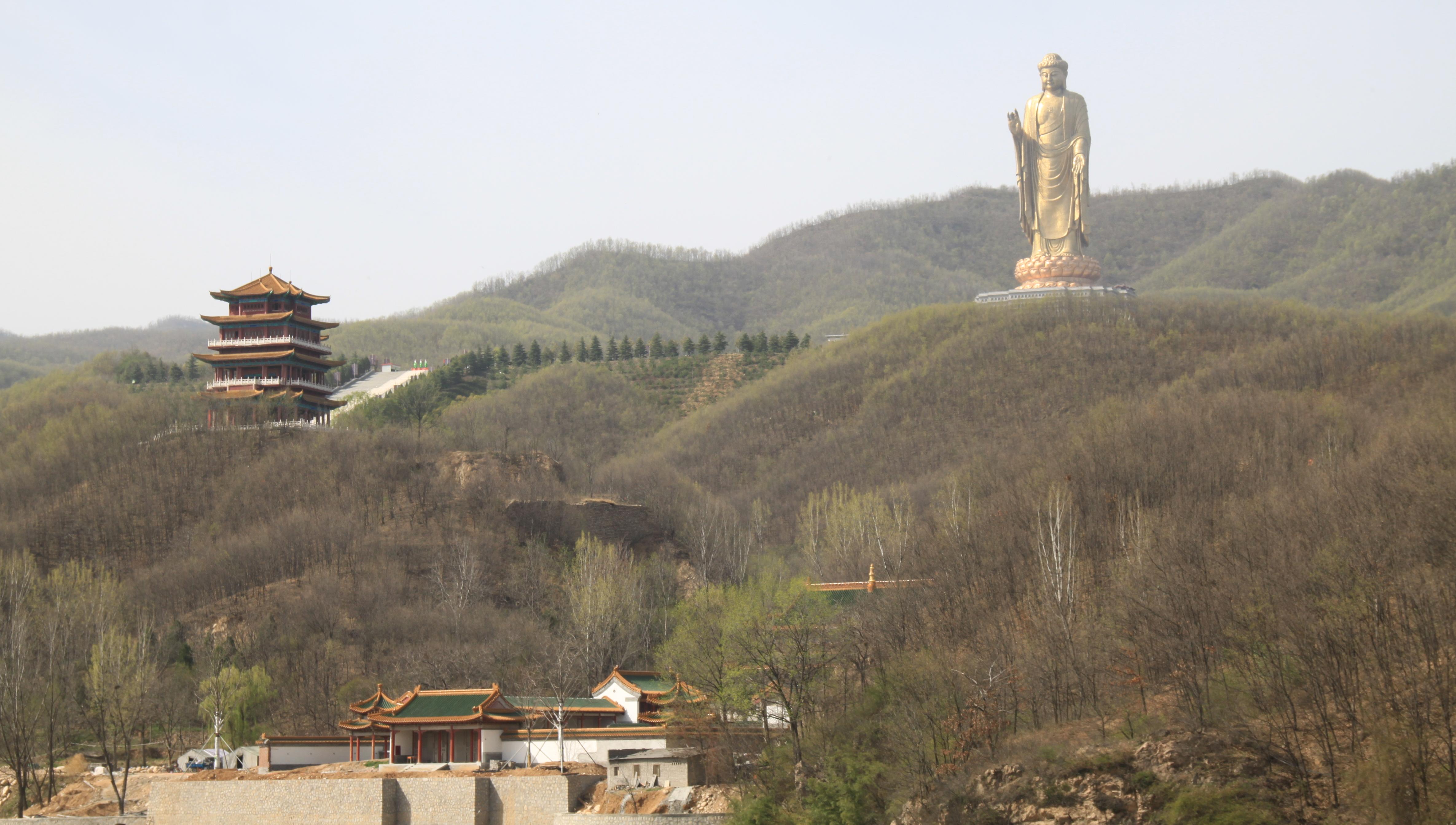
Standing an astonishing 153 meters (502 feet) tall, the Spring Temple Buddha in Henan, China, is one of the tallest statues in the world, towering over the surrounding countryside with an almost divine presence. Completed in 2008, this massive, golden-gilded statue depicts Vairocana Buddha, a celestial figure symbolizing wisdom and enlightenment in Mahayana Buddhism. What makes this monument even more impressive is its intricate, layered construction. The Buddha stands atop a massive lotus throne, which in turn sits on a three-tiered pedestal resembling a monastery, bringing the total height of the structure to 208 meters (682 feet) when measured from its base. Built near the Tianrui Hot Spring, the statue’s location was chosen for its association with healing waters and spiritual rejuvenation. Visitors can climb a monumental staircase leading up to the base of the statue, offering breathtaking panoramic views of the surrounding landscape. With its golden sheen reflecting the sunlight, the Spring Temple Buddha is a true colossus, exuding an air of peace, grandeur, and divine power.
4. El Gigante de Tula – Mexico’s Forgotten Titan
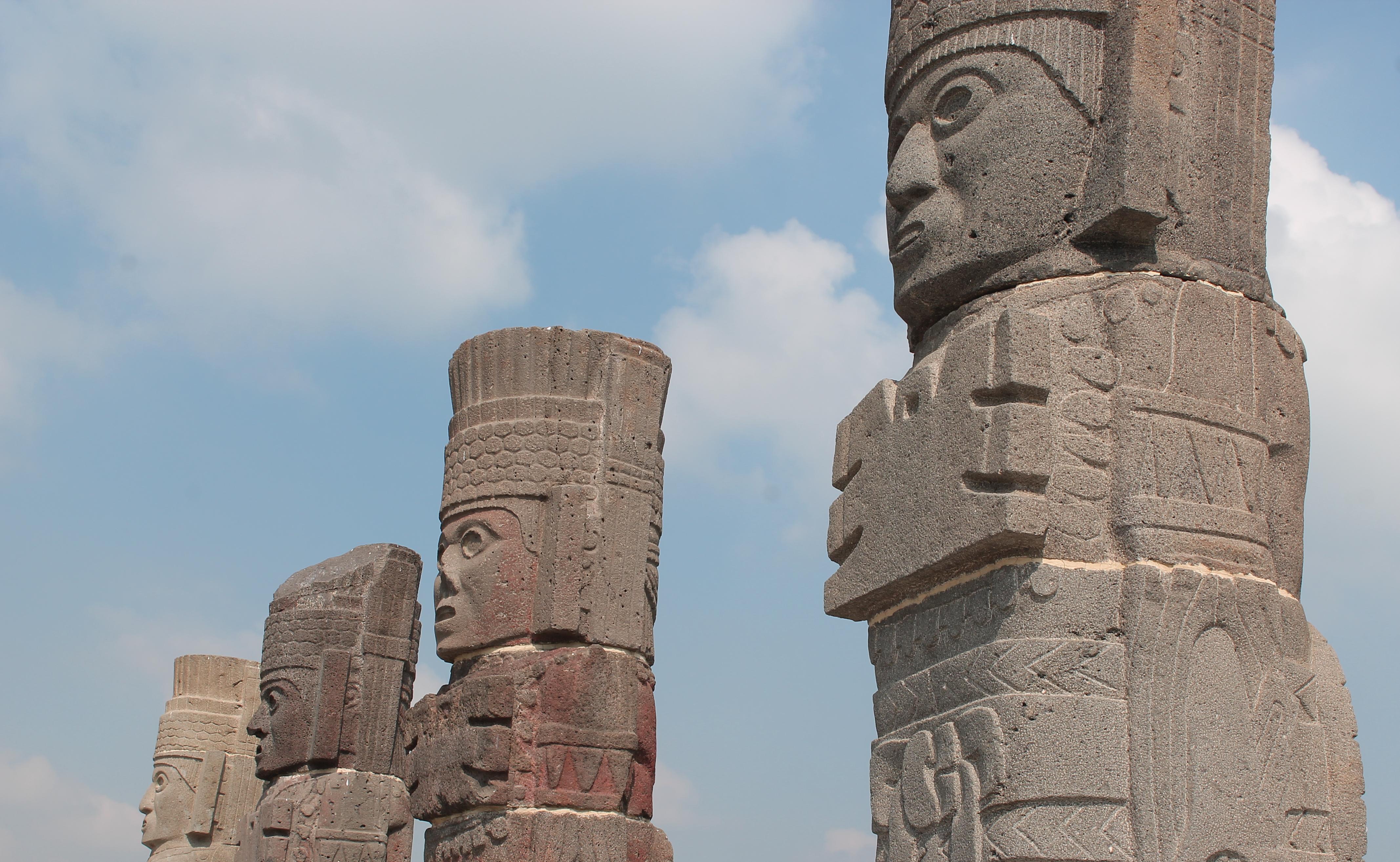
High atop the ancient ruins of Tula, Mexico, stand the Atlantean figures, also known as El Gigante de Tula. These stone warriors, carved by the Toltec civilization over 1,000 years ago, are not as tall as modern statues, standing at 4.6 meters (15 feet) each, yet their otherworldly presence and imposing stature make them unforgettable. These massive stone guardians once supported the roof of a grand temple dedicated to Quetzalcoatl, the feathered serpent god. Each figure is carved with intricate armor, headdresses, and weaponry, representing powerful Toltec warriors or possibly deities. Unlike statues meant for simple admiration, the Atlantean figures of Tula serve as a testament to an ancient warrior culture, shrouded in legend and mystery. Their rigid, imposing posture, coupled with their enigmatic, expressionless faces, gives them an almost extraterrestrial quality, leading to numerous theories about their origins. Located on the pyramid-like ruins of Tula, these towering sentinels stand as the last remnants of a forgotten empire, watching over the valley below as if awaiting the return of their creators. The air of mystique and quiet authority surrounding El Gigante de Tula makes it one of Mexico’s most fascinating yet underrated monuments.
5. The Terracotta Army: Guardians of the Afterlife
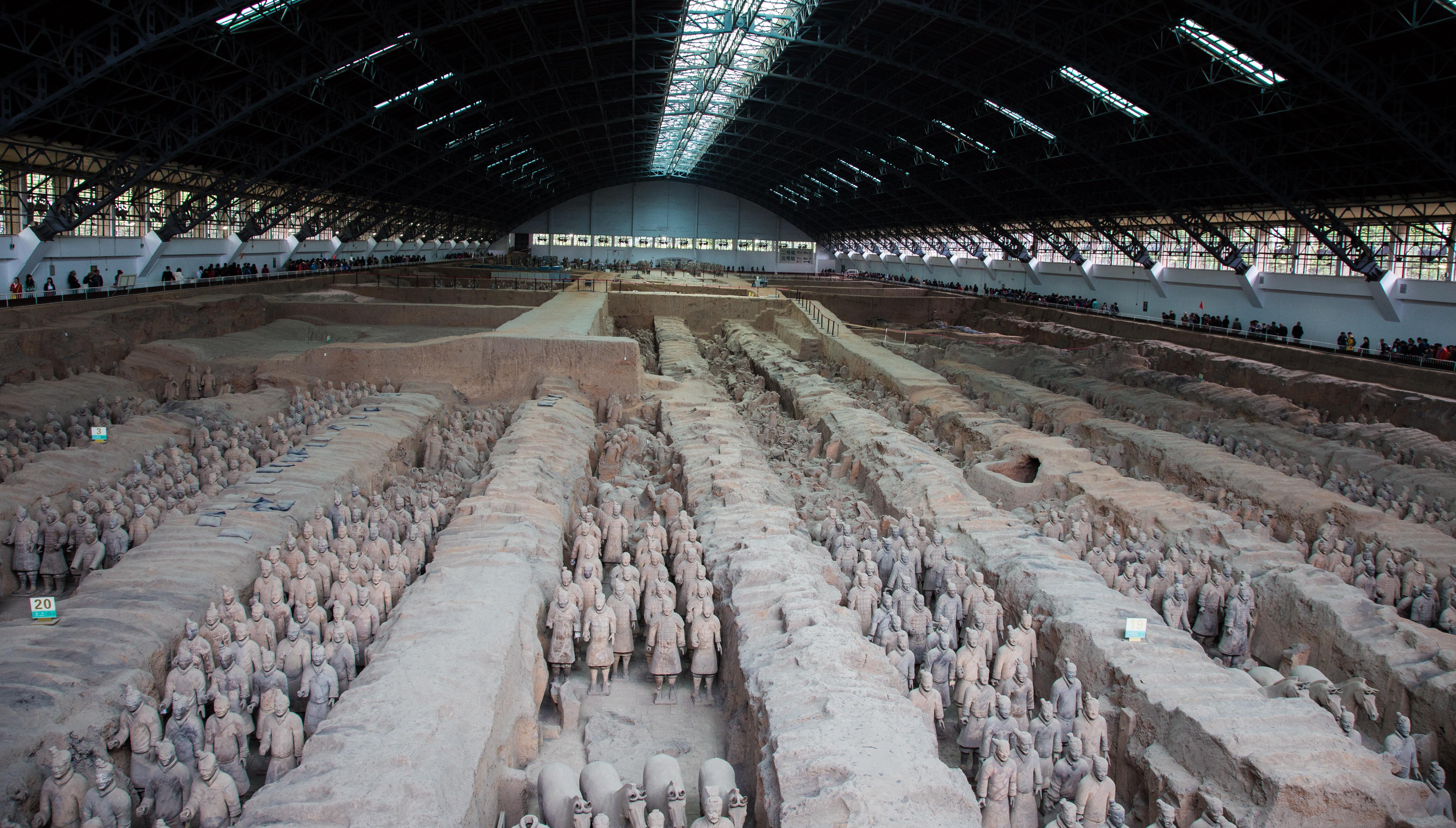
Buried for over 2,000 years, the Terracotta Army was one of the greatest archaeological discoveries of the 20th century. Unearthed in 1974, this staggering collection of over 8,000 life-sized clay soldiers was created to accompany China’s first emperor, Qin Shi Huang, into the afterlife. Each warrior is unique, with distinct facial expressions, armor, and weaponry, reflecting the diversity and hierarchy of the emperor’s forces. In addition to soldiers, the underground complex contains horses, chariots, and even acrobats, all meticulously sculpted to ensure the emperor’s dominance in the next world. Historians believe the Terracotta Army was never meant to be seen by human eyes again, making its discovery a breathtaking glimpse into the past. The sheer scale and craftsmanship of this buried army make it one of the most astonishing funerary monuments ever created. Visiting the Terracotta Army site in Xi’an, China, is a humbling experience, offering a window into the ambitions of an emperor who sought to rule beyond death. The warriors, though silent, stand eternal guard over one of history’s greatest empires, preserving an ancient world frozen in time.
6. The Virgin of El Panecillo – Ecuador’s Winged Madonna

Perched atop El Panecillo hill in the heart of Quito, Ecuador, the Virgin of El Panecillo is one of the most breathtaking and unique depictions of the Madonna in the world. Towering 45 meters (148 feet) tall, this gleaming aluminum statue is not only one of the tallest sculptures in South America but also one of the few representations of the Virgin Mary with angelic wings—a striking departure from traditional depictions. Constructed in 1976 by Spanish artist Agustín de la Herrán Matorras, the monument was inspired by a 1734 wooden sculpture crafted by Bernardo de Legarda, an artist from Ecuador's famed Quito School of Art. The location of the statue is just as significant as the figure itself. El Panecillo, which translates to “The Little Loaf”, is a natural hill rising 200 meters (656 feet) above the city, providing a stunning panoramic view of Quito’s historic center, a UNESCO World Heritage Site. From this vantage point, visitors can take in the breathtaking sight of Quito’s colonial-era churches, cobbled streets, and surrounding Andean peaks.
7. Tian Tan Buddha – Hong Kong’s Island Guardian

Rising 34 meters (112 feet) above the lush landscape of Lantau Island, Tian Tan Buddha, also known as the Big Buddha, is one of Hong Kong’s most revered and awe-inspiring monuments. Unlike most colossal Buddhas found in temples or urban landscapes, this bronze giant sits serenely atop Ngong Ping Plateau, surrounded by misty mountains and the sparkling waters of the South China Sea, making it an unparalleled spiritual retreat for visitors from around the world. Completed in 1993 after 12 years of construction, Tian Tan Buddha was crafted entirely of bronze, weighing a staggering 250 metric tons (551,000 pounds). Unlike many Buddha statues that are cast in one solid piece, this masterpiece was created using 202 separate bronze panels, assembled to form a harmonious whole. The statue sits atop a lotus throne, a symbol of purity and enlightenment, surrounded by six smaller bronze statues representing the “Six Devas”, offering gifts to the Buddha as expressions of the six perfections in Buddhism: generosity, morality, patience, zeal, meditation, and wisdom.
8. Kailasa Temple – India’s Rock-Cut Masterpiece

While not a statue in the traditional sense, the Kailasa Temple at the Ellora Caves in India is one of the most jaw-dropping and colossal monuments in the world. Unlike most temples that are built stone by stone, this entire complex was carved downward from a single rock face in the 8th century, an engineering marvel that continues to baffle historians and archaeologists. The temple complex is so large that it includes towering pillars, detailed friezes, massive courtyards, and multi-tiered halls, all crafted with an astonishing level of precision. Perhaps the most surreal aspect of the Kailasa Temple is that it was constructed in reverse, with ancient artisans chiseling downward into the rock rather than assembling it from the ground up—a feat nearly impossible to replicate with modern tools. Legends claim that the temple was built in a single night by divine intervention, while others believe it was created under the orders of a king who sought to mimic Mount Kailash, the mythical abode of Lord Shiva. The temple’s remarkable scale, surreal carvings, and enigmatic history make it a true monument beyond reality, proving that human ambition and artistry know no limits.
9. The Motherland Calls – Russia’s Towering Warrior
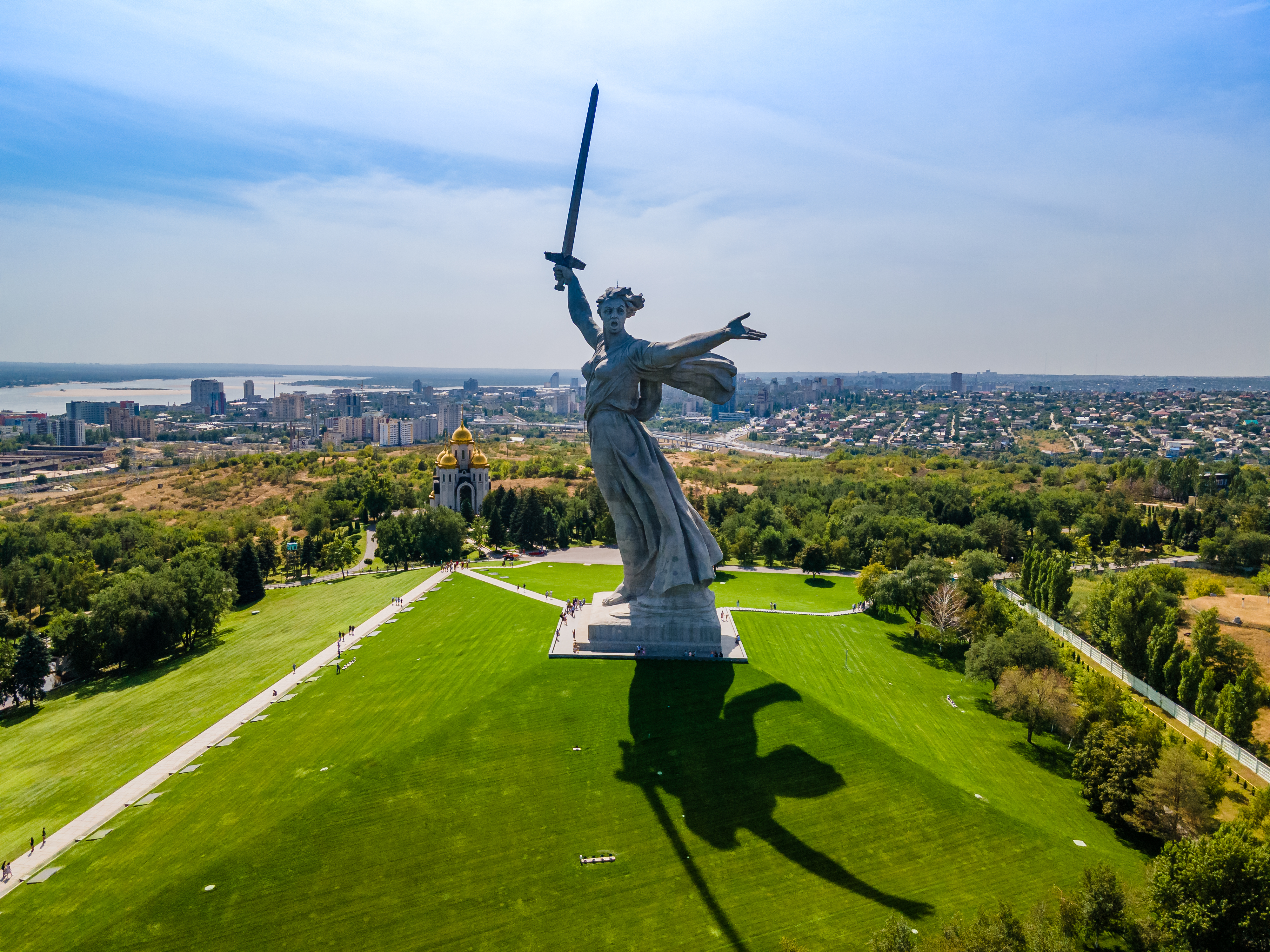
Few monuments in the world exude as much raw power and emotion as The Motherland Calls in Volgograd, Russia. This colossal statue stands at 85 meters (279 feet), making it one of the tallest statues in the world—taller than both the Statue of Liberty and Christ the Redeemer. Unlike many rigid or symmetrical statues, The Motherland Calls is dynamic and full of movement, with a flowing robe and windswept hair that make it seem as if she is stepping forward, sword raised, ready to lead an army into battle. This imposing figure is a tribute to the Battle of Stalingrad, one of the bloodiest and most decisive battles of World War II. The statue represents Mother Russia calling upon her children to rise and defend their homeland against invaders. Her expression is fierce, her stance commanding, and the sheer scale of her outstretched arm and sword makes her one of the most visually striking monuments on the planet.
10. Guanyin of Nanshan – China’s Triple-Faced Guardian

Unlike most religious statues that face in a single direction, the Guanyin of Nanshan in China is a unique triple-faced statue that symbolizes peace, wisdom, and compassion. Standing at an astounding 108 meters (354 feet), this serene figure of Guanyin, the bodhisattva of mercy, towers over the shores of Hainan Island, its golden and white surfaces shimmering under the sun. Each of the three faces represents a different aspect of Buddhist enlightenment: one gazes forward towards the ocean, blessing the people; another looks towards the land, offering wisdom; and the third symbolizes the unification of past, present, and future. The statue stands upon a lotus-shaped platform, emerging from the sea like a celestial apparition, adding to its otherworldly beauty. Visitors must cross an elaborate causeway to reach the base of the statue, where a Buddhist temple complex awaits, filled with ornate carvings, intricate shrines, and flowing incense. Many believe that standing beneath Guanyin’s watchful gaze brings blessings and protection, making this monument not just a marvel of scale but also a deeply spiritual experience.
11. The Cristo de la Concordia – Bolivia’s Giant Redeemer

While Christ the Redeemer in Brazil is famous worldwide, few people realize that Bolivia boasts an even taller Christ statue—Cristo de la Concordia in Cochabamba, which stands at 40.4 meters (133 feet). This monumental figure of Christ towers over the city from San Pedro Hill, his arms outstretched in a welcoming embrace that spans nearly 30 meters (98 feet) wide. One of the most unique aspects of this statue is that visitors can actually climb inside it. A narrow spiral staircase leads up through the body of Christ, culminating in an observation deck at chest level. From here, visitors are rewarded with a spectacular panoramic view of Cochabamba, a sprawling city framed by the rugged Bolivian mountains. Constructed in 1994, Cristo de la Concordia was designed to surpass Christ the Redeemer’s height, making it one of the tallest Jesus statues in the world. At night, the statue is illuminated in a soft white glow, appearing almost spectral against the night sky. Whether viewed from afar or up close, this breathtaking monument is a powerful symbol of faith, resilience, and unity.
12. El Santuario de las Lajas – Colombia’s Cliffside Cathedral
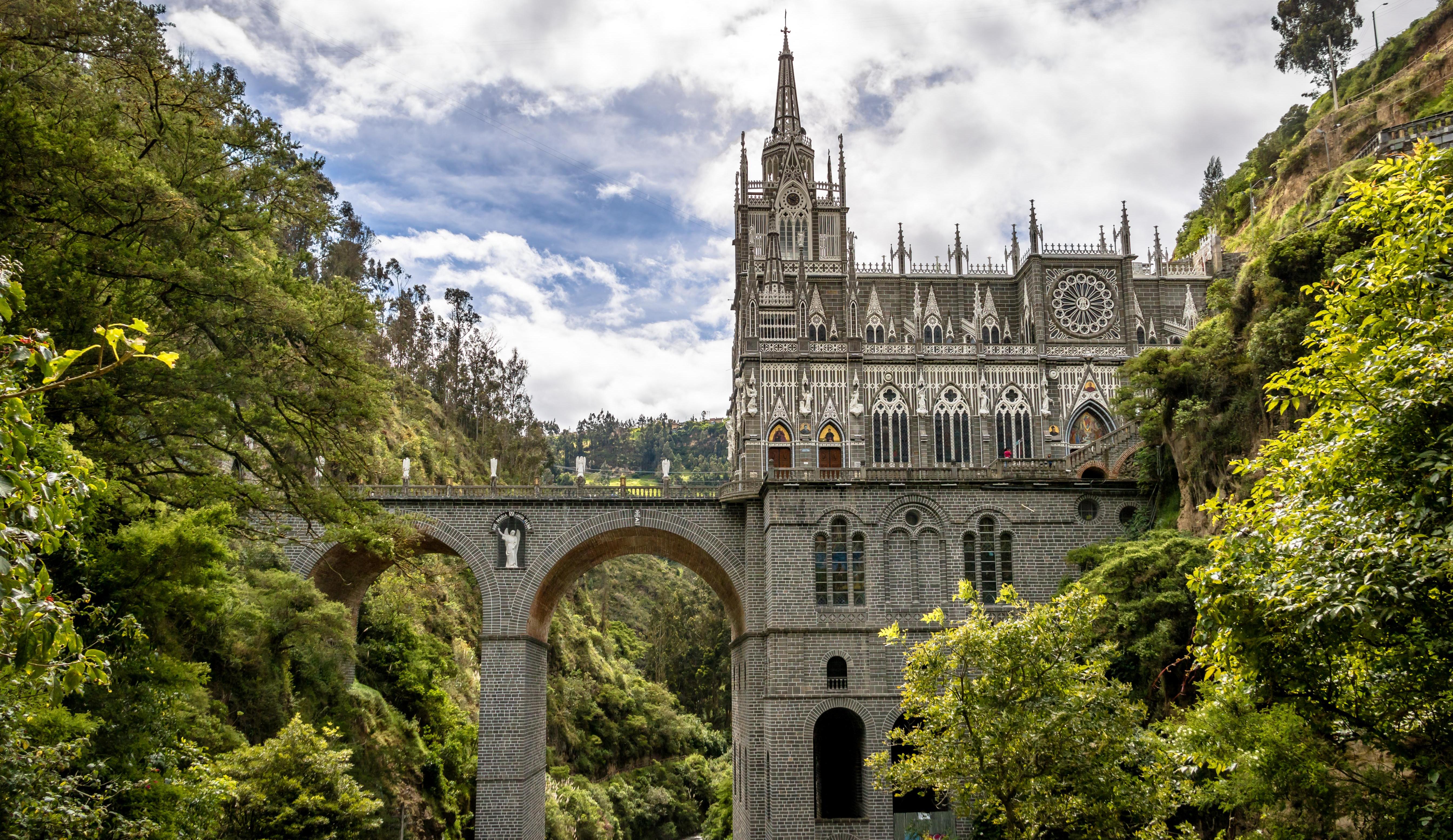
Often referred to as “the most beautiful church in the world,” El Santuario de las Lajas is unlike any other religious monument. Built into the steep cliffs of southern Colombia, this Gothic cathedral seems to defy gravity, hovering over a dramatic gorge with towering bridges and elegant spires. According to legend, in the 18th century, the Virgin Mary appeared to an indigenous girl and her mother on these cliffs, leading to the construction of the church as a place of worship and miracles. The current structure, completed in 1949, is a masterpiece of Neo-Gothic architecture, featuring delicate stained glass windows, intricate stonework, and statues of saints carved directly into the rock face. At night, the church is lit up in dazzling colors, enhancing its fairy-tale appearance and making it look like something from a dream. Pilgrims from around the world travel to Las Lajas to seek healing and divine blessings, while visitors marvel at its unreal beauty. This is not just a church—it is a monument that blends faith, legend, and architectural genius into one of the most surreal sights on Earth.
13. Hanuman Murti – India’s Mighty Monkey God

Towering at 53 meters (174 feet), the Hanuman Murti in New Delhi, India, is a colossal tribute to Hanuman, the powerful monkey god of Hindu mythology. Unlike many solemn religious statues, Hanuman is depicted in a bold and dramatic pose, tearing open his chest to reveal his undying devotion to Lord Rama. The vibrant red and gold statue stands out against the city skyline, attracting devotees who come to seek strength, protection, and courage. Hanuman, known for his superhuman abilities, is revered as a guardian figure, a warrior, and a symbol of unwavering faith. Each week, thousands of pilgrims gather at the base of the statue to offer prayers, flowers, and sweets, creating an atmosphere of devotion and energy. During Hindu festivals, the statue is bathed in colorful powders and draped in garlands, transforming it into an even more striking spectacle. For both believers and visitors, the Hanuman Murti is a powerful monument of myth, faith, and larger-than-life devotion.
14. The Soviet Monument to the Revolution – Bulgaria
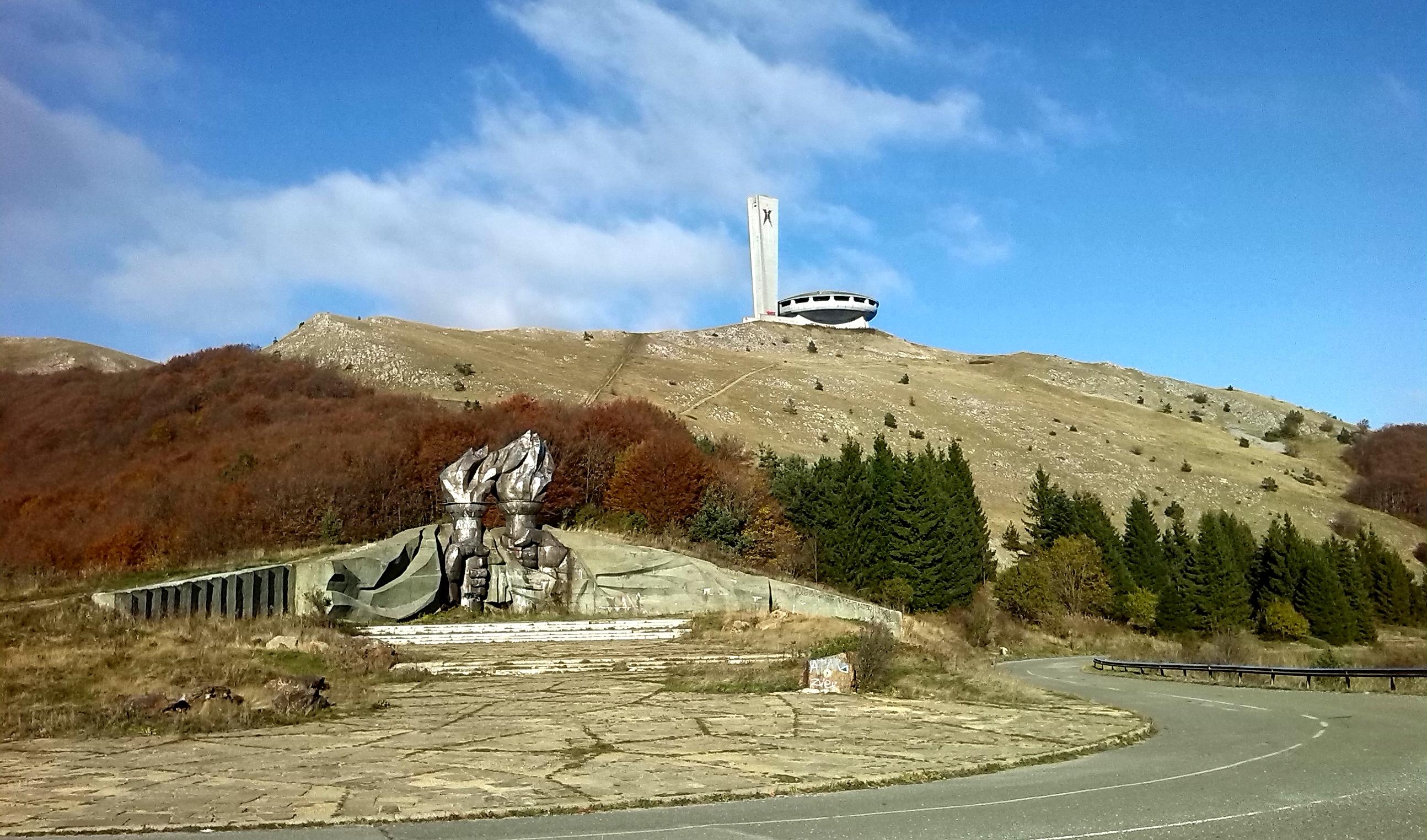
Hidden deep in the Balkan Mountains, the Buzludzha Monument looks like something out of a dystopian future. Built in 1981 as a symbol of Communist power, this massive, abandoned UFO-like structure once housed grand halls and a towering spire bearing the Communist star. Today, it sits in eerie decay, its red-star insignia shattered, mosaics of Lenin and Marx peeling away, and its concrete husk battered by time. The wind howls through its empty halls, and visitors brave enough to enter describe an overwhelming sense of being watched. The abandoned relic feels less like a monument and more like an alien ruin, standing as an ominous reminder of a once-powerful ideology that crumbled into dust.
15. The Mask of Sorrow – Russia

Perched in Magadan, Siberia, The Mask of Sorrow is a terrifying monument dedicated to the victims of Stalin’s forced labor camps. The towering stone face, with empty, crying eyes and a fragmented structure, is meant to evoke the suffering, pain, and loss experienced in the Soviet gulags. Its grim, hollow stare and surreal design make it one of the most unsettling statues in the world. The surrounding desolate landscape, blanketed in snow for most of the year, adds to the monument’s haunting aura. Standing before it, visitors are confronted with the chilling realization of millions who perished in Siberia’s frozen wastelands.
16. The Valley of the Fallen – Spain

Carved into a mountain outside Madrid, The Valley of the Fallen is a gargantuan and eerie memorial ordered by dictator Francisco Franco. It features a 500-foot-tall stone cross towering over a basilica literally carved into the mountain. Built using the forced labor of political prisoners, the site was intended as a symbol of national unity but remains one of Spain’s most controversial places. Inside, the dimly lit halls echo with an almost supernatural silence, and many Spaniards believe the place is haunted by the spirits of those who suffered during its construction. Whether seen as a religious sanctuary or a grim reminder of dictatorship, this eerie colossus looms over Spain’s complex history like a ghost that refuses to be forgotten.
17. The African Renaissance Monument – Senegal

At 49 meters (160 feet) tall, the African Renaissance Monument in Dakar, Senegal, is the tallest statue in Africa—but it has also been one of the most controversial. Depicting a gigantic, muscular man holding a child aloft while his partner reaches outward, the monument was intended to symbolize Africa’s future and rebirth. However, its oversized, exaggerated human figures, combined with its eerie, expressionless faces, give it an uncanny, unsettling quality. Built by North Korean architects, its Soviet-style proportions and stiff design clash with its intended message, making it feel more imposing than inspiring. The monument’s massive, shadowy presence over Dakar has led some locals to nickname it "The Giant That Watches Over Us"—whether as a protector or a silent judge is up for debate.
18. The Monument to the Partisans – Croatia
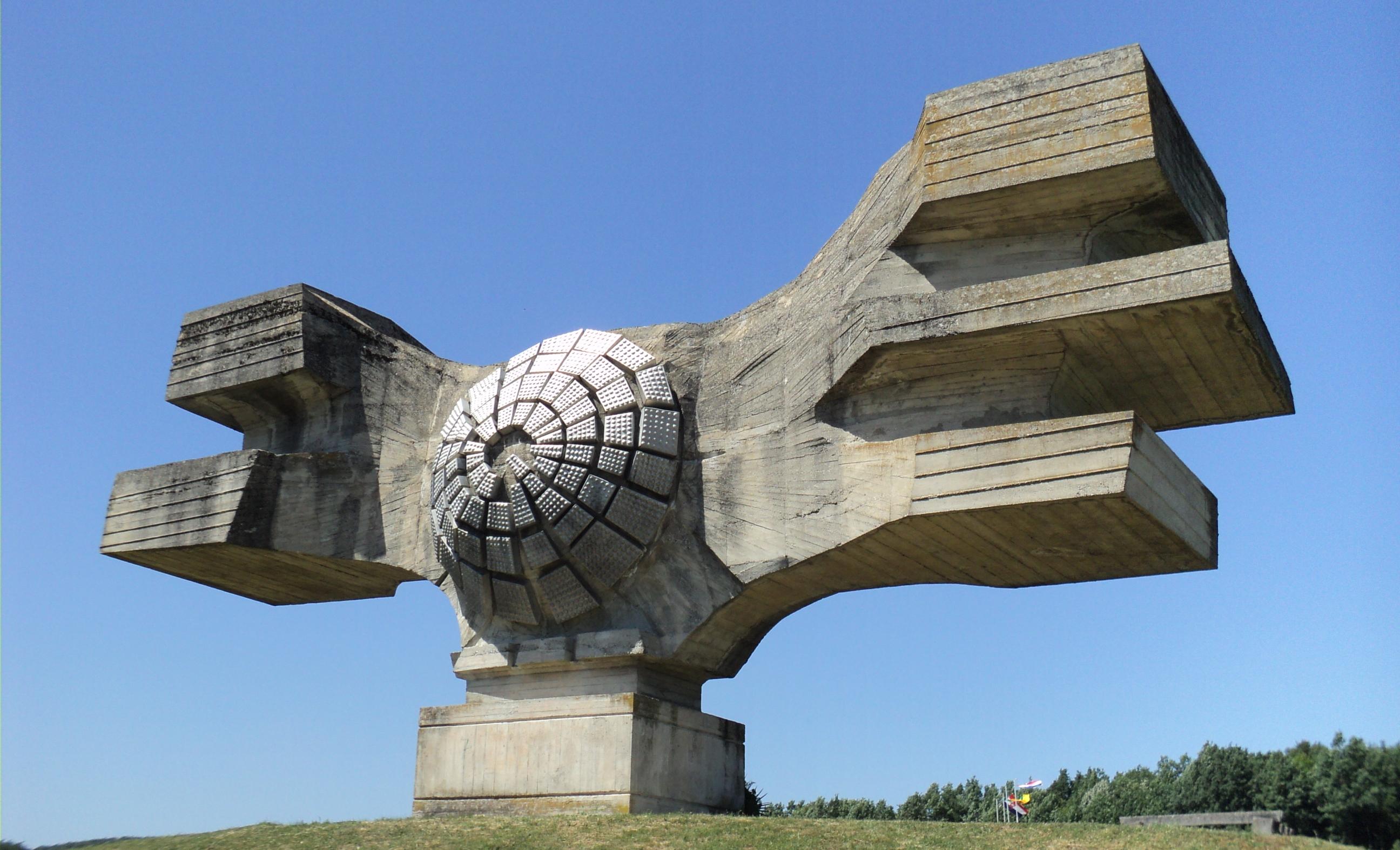
High in the mountains of Podgarić, Croatia, stands a brutalist, otherworldly concrete structure resembling a pair of enormous alien wings. This cold, imposing monument was built in the 1960s to honor Yugoslav partisans who fought in World War II, but today, it feels more like a relic from a forgotten civilization. Its massive, curved concrete forms loom eerily against the forested hills, looking less like a war memorial and more like a gateway to another dimension. The isolated location and the silence that surrounds it add to the unease—standing before it, you feel as if you've stumbled upon something not meant for human eyes.
19. The Giant Hand of the Desert – Chile

Emerging from the Atacama Desert like a supernatural relic, La Mano del Desierto (The Hand of the Desert) is a 36-foot (11-meter) tall stone hand reaching toward the sky. Created by Chilean sculptor Mario Irarrázabal, the monument is meant to symbolize human suffering, isolation, and helplessness. However, its gigantic size and eerie placement in the middle of the world’s driest desert make it feel almost alien. The sheer emptiness of the surrounding landscape amplifies the hand’s haunting presence, leaving visitors with the chilling impression that something enormous is trying to claw its way out of the Earth.
20. The Motherland Monument – Ukraine

Rising over 102 meters (335 feet) high, The Motherland Monument in Kyiv, Ukraine, is one of the most intimidating statues ever built. Depicting a stern-faced, armor-clad woman wielding a massive sword and shield, she is meant to represent the strength and resilience of the Soviet Union—but instead, she comes off as an imposing, cold, godlike figure gazing down upon the city. During storms, lightning strikes her sword, creating a spectacular yet eerie effect, as if the statue itself is alive. Many Ukrainians have called for its removal due to its Soviet legacy, but for now, it remains standing—a silent, iron-faced guardian over Kyiv.
21. The Thunderbirds of Mount Nemrut – Turkey

Atop Mount Nemrut, high above the Anatolian plains, lie the severed heads of ancient gods, gazing blankly into the distance. Built by King Antiochus I of Commagene in the 1st century BC, this mountaintop sanctuary was meant to honor a fusion of Greek and Persian deities. Over time, earthquakes and erosion caused the massive stone heads—each several meters high—to topple from their bodies, creating one of the most surreal and unsettling sights in archaeology. The best time to visit? Sunrise or sunset, when the shadows stretch across the ruins, making it feel as if the gods are watching and waiting.
22. The Giant Lenin Head – Russia

In the remote Siberian city of Ulan-Ude, a giant, 42-ton, 25-foot-tall bronze head of Vladimir Lenin sits in the city square. Not a full statue—just a disembodied head, it is one of the largest depictions of Lenin ever built, with piercing eyes and an expression so severe it feels as though he is staring directly into your soul. While other Lenin monuments across Russia have been taken down, this grim relic of Soviet rule remains, its immense presence dominating the city like a ghost of the past that refuses to fade.
23. The Shigir Idol – Russia

Unlike the other monuments on this list, the Shigir Idol isn't a modern or medieval creation—it is 12,000 years old, making it the oldest known monumental wooden sculpture on Earth. Discovered in a Russian bog in 1890, this twice-human-sized totem features eerie, geometric carvings and faces stacked on top of one another, staring out with hollow, ancient eyes. Experts believe the carvings hold a long-forgotten message from a lost civilization, but no one knows exactly what it means. Older than the pyramids, Stonehenge, and nearly all recorded history, the Shigir Idol is an unsettling reminder that long before us, there were people creating things—things we may never fully understand.
When Legends Touch the Sky

Each of these monumental wonders is more than just an architectural feat—they are stories frozen in time, whispering tales of devotion, resilience, and the pursuit of greatness. Whether it's the mystical gaze of an ancient Buddha, the unyielding stance of a warrior, or the ethereal beauty of a celestial guardian, these statues remind us that human creativity knows no bounds. Some of these giants have watched over civilizations for centuries, standing against wars, earthquakes, and the passage of time, while others are newer tributes to culture and faith, carrying the hopes of generations into the future. But regardless of when or where they were built, they all serve the same purpose—to inspire, to provoke wonder, and to remind us that the impossible is always within reach. These colossal creations are more than just stone and metal—they are monuments to the extraordinary, ensuring that even as time marches on, their stories will never fade.


